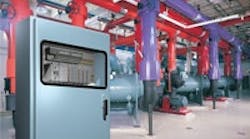With workforce shortages, many plant managers are looking for ways to consolidate roles and reduce the risk of unplanned downtime. One method that is quickly gaining ground is integrating condition monitoring with the factory’s control and information-level networks. This move gives control engineers the machine intelligence they need to identify and address issues before they become problems — a proactive approach that reduces the strain on lean maintenance and operations teams.
In years past, condition monitoring primarily relied on proprietary hardware and configuration tools, as well as maintenance personnel with specialized skills in system management and vibration analysis. The complex, proprietary model created a barrier for most small — and medium-sized manufacturers because the condition monitoring systems were too costly for their business models.
Recent advances in condition monitoring systems include better diagnostic intelligence, advanced signal processing, and the support of open industry standard networks, making it possible for condition monitoring to be applied in a more cost-effective manner. Plus, scalable designs no longer force a small bakery to use the same condition monitoring package as a large refinery or power plant.
These advances in technology could not come at a better time. Manufacturers are under unprecedented pressure to automate and better integrate all critical functions, produce smaller lot sizes on demand, and reduce labor costs.
To implement an integrated condition monitoring model, begin by identifying the critical machines that can significantly impact production if a failure occurs. Once these machines are identified, determine common issues that can lead to a failure. Most often these issues are unbalance, misalignment, looseness and bearing defects. This information helps determine which sensor best fits the application and proper system configuration.
[pullquote]The next step involves selecting a vibration monitor to connect to sensor cabling and integrate into the automation and control system. Easier than in years past, intelligent vibration monitors now feature form factors that are ideally suited for field installation. These monitors are compatible with open networks, such as DeviceNet, to help simplify sensor wiring by allowing installation closer to the machine. The vibration monitor can be connected directly or bridged via an existing network to a HMI or programmable automation controller (PAC).
For applications that do not require real-time monitoring (only data acquisition and processing every few minutes or hours), the vibration monitor can be combined with a PAC and relay card components to process data and sequentially route signals. This approach can help reduce the cost per channel.
Integrating a condition monitoring system with a PAC also creates an automated continuous diagnostic system. Using basic logic to apply vibration diagnostic rules, the PAC looks at the data values and statuses to determine if an activity, such as high vibration, is due to one or more common faults. Then, the PAC relates the fault to a specific message that can be sent to the appropriate personnel, even sending an e-mail, pager message or text message for immediate action.
When incorporated correctly into the existing plant architecture, a condition monitoring system can help a plant improve machinery reliability, better communicate critical information and reduce total cost of ownership.
